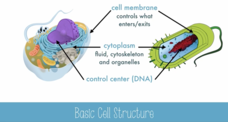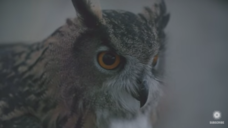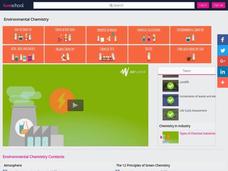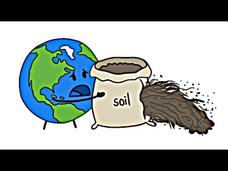Deep Look
These Lizards Have Been Playing Rock-Paper-Scissors for 15 Million Years
Most species use one way of attracting a mate, whether through physical displays, alluring sounds, or aggression. The side-blotched lizards use three different ways, providing balance to their ecosystem. While the males use their own...
Deep Look
These Carnivorous Worms Catch Bugs by Mimicking the Night Sky
Have you ever wanted to lay inside a cave and look up at thousands of stars twinkling? Caves in New Zealand have glow worms that mimic the night sky in order to confuse their prey. This allows the worms to trap their prey and eat them...
Deep Look
This Vibrating Bumblebee Unlocks a Flower's Hidden Treasure
Some plants lock their pollen up until feeling the correct password. The video explains buzz pollination and how it differs from the pollination of other types of flowering plants. It lists multiple plants that require it and...
Deep Look
Sea Urchins Pull Themselves Inside Out To Be Reborn
Sea Urchins live for centuries if they can make it to adulthood. The video highlights the challenges of sea urchins making the journey through the open sea for years. When they finally find a place to land, an amazing transformation occurs.
Deep Look
Can the Frog Apocalypse be Stopped by a New "Vaccine"?
Thanks to chytrid fungus, the list of endangered and extinct amphibians has grown by around 200 species. The video details how the fungus attacks frogs, specifically the yellow-legged mountain frogs in California. It then offers hope...
Teacher's Pet
Genes and Chromosomes
Doctors sometimes order a karyotype, a picture of the chromosomes present in a single cell, in order to check for chromosomal abnormalities or rare diseases. The video explains the relationship among genes, chromosomes, and karyotypes....
Teacher's Pet
DNA versus RNA
Explain the differences between DNA and RNA with a short video that includes information about the uracil versus thymine contrast and includes details about structural, functional, and bond discrepancies.
Teacher's Pet
Cell Cycle
The video Introduce class members to the cell cycle and chromosomes with a video that explains the difference between diploid and haploid chromosomes.
Teacher's Pet
Photosynthesis and Respiration
A video describes the relationship between anaerobic respiration and photosynthesis and then connects the cycle to the creation of ATP.
Teacher's Pet
Leaf Pigments and Light
Why do leaves change color in the fall? The video explains the relationship between chlorophyll and light, connects the concepts of light to photosynthesis, relates the visible color spectrum to electromagnetic radiation.
Teacher's Pet
Introduction to Photosynthesis
Introduce viewers to photosynthesis with a video that begins by explaining the differences between heterotrophs and autotrophs. Then it describes photosynthesis and offers the chemical equation for this process.
Teacher's Pet
Passive Transport Part 1
In video games, some items go through walls while others are stopped by walls. This analogy also applies to the semi-permeable cell walls. The video explains two types of passive transport due to semi-permeable walls. It first covers...
Teacher's Pet
Cell Diversity, Shape and Size
Do stem cells tell their kids they can grow up to be anything they want to be? The video discusses the large diversity in different types of stem cells and relates how shape and size determine function.
Teacher's Pet
Using Math to Analyze Data
No one wants to be average, so mathematicians use the term mean instead of average. The video explains how to calculate the mean, how to calculate the percent error, and why this information is important. Finally, the video considers the...
Deep Look
What Happens When You Zap Coral With The World's Most Powerful X-ray Laser?
By examining coral skeletons with powerful X-ray technology, scientists are able to track climate change before written records were produced. Learn how in a fascinating video short video.
Deep Look
How Do Sharks and Rays Use Electricity to Find Hidden Prey?
Sharks and stingrays use their sense of electricity to find prey. The video explains their tiny organs that detect electric fields produced by living creatures. It ends by highlighting the benefits of this sense and how much scientists...
Deep Look
Why Jellyfish Float Like a Butterfly—And Sting Like a Bee
Jellyfish predate dinosaurs by 400 million years. The video explains how jellyfish without a heart, blood, or a brain have survived longer than most other species. It details two of their tricks for adapting and finding prey as their...
Deep Look
What Makes Owls So Quiet and So Deadly?
Known as excellent hunters, owls don't fly with the fast speeds of other birds of prey. The video focuses on the feathers and nocturnal habit of owls. With quiet, almost silent flight, owls sneak up on their prey.
Deep Look
These Crazy Cute Baby Turtles Want Their Lake Back
Western pond turtles struggle to survive in areas with high pollution and invasive species. The video highlights how zoos help the turtles. and demonstrates a partnership between zoos and the environment around them.
Deep Look
This Mushroom Starts Killing You Before You Even Realize It
Death cap mushrooms cause the most fatal mushroom poisonings worldwide. The video explains where they grow, how the toxin works, and how our bodies react to eating them. Then, it offers a glimpse into the research scientists are doing to...
Deep Look
This Pulsating Slime Mold Comes in Peace (ft. It's Okay to Be Smart)
Can you name an organism that isn't a plant, animal, or fungus? Here's a hint: each cell contains thousands of nuclei. Slime mold may not have any appendages, but their movements fascinate scientists. The video focuses on these unique...
Deep Look
Sticky. Stretchy. Waterproof. The Amazing Underwater Tape of the Caddisfly
Did you know that the caddisfly creates a tape that is not only water proof, but also stretches like a rubber band. Learn more about caddisflies with a video explains What scientists are discovering about an insect with aquatic larvae.
Fuse School
Types of Chemical Industries
Four percent of the world's CO2 emissions come from the chemical industry. The video discusses the environmental impact of industry. From using non-renewable resources, requiring high levels of energy, to polluting the ground, water, and...
MinuteEarth
How To (Literally) Save Earth
Soil naturally erodes and produces new soil at the same rate when left to nature, yet farming erodes the soil 50 times faster than it forms. The video discusses soil, the ways humans damage it through their actions, and encourages many...























